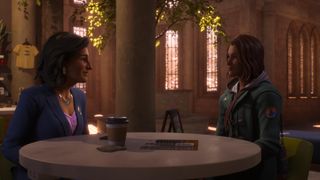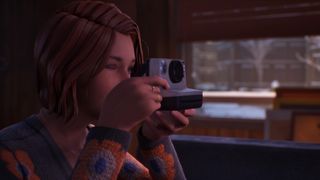Products You May Like
Review info
Platform reviewed: PS5
Available on: PS5, Xbox Series X, Xbox Series S, PC, Nintendo Switch
Release date: October 29, 2024 (Nintendo Switch TBC)
In retrospect, Life is Strange: Double Exposure seems like an almost impossible sequel for developer Deck Nine to create. Even if that’s not the case, it’s hard to argue that the one we received is a success.
Who is Max Caufield? That depends on the decisions you made playing the first episodic supernatural adventure game. Don’t Nod’s 2013 success with the original Life is Strange was a lightning bolt, an episodic coming-of-age story driven by the emotional impulses of both the player and Max acting as one. Returning to Arcadia Bay and meeting your lost friend culminating in a decision to save her life and destroy your hometown or allow her to die to save it, commits the first game to a contained but forceful and emotional arc about the morality of controlling the fates of others.
In Life is Strange: Double Exposure, Max is no longer the teenager we once knew. She’s an adult, a photographer-in-residence, and a teacher at Caledon University in Vermont. She has a new life. She can’t use her rewind powers anymore to turn back time, but she’s seemingly settled in a new home and has two close friends in the geeky astronomer Moses and Safi, a poet and undergraduate.
One night, after watching a meteor shower on the snowy observatory rooftop, Safi leaves to take a phone call only to be shot dead in the night by a mystery assailant. Shocked by trauma, Max discovers a new ability to switch between a timeline where she lives and one where she dies, and uses this ability to try and understand her death, who killed her, and perhaps even save her.
Scars of the Past

Make no mistake, my disappointment with Life is Strange: Double Exposure doesn’t come from a disdain for the decision not to bring back fan-favorite Chloe, Max’s romantic interest from the first game. While there has been some controversy over this decision, as she fails to make an appearance regardless of whether you let her live or die in the first game, this is not what holds things back narratively.
The overhanging cloud of Arcadia Bay, and the gulf between the state of reality where Chloe lives and dies, are so massive that attempting to tell a story that fails to commit to making one ending canon (or possibly both) results in a game that seems unable to move beyond history to explore who Max is today. Max claims that she has moved on, but the game inherently can’t. The result hamstrings the story from developing in certain directions at risk of contradicting either ending while stopping it from really having anything interesting to say by the time credits roll.
The result is a big disconnect between Max and the player. You may remember the events of the first game, and they may influence the way you act here, but the story can’t acknowledge them. The loss of your friend and love interest, or the loss of an entire town, are major events that should define Max but are entirely absent aside from a few easter eggs.

Narrative aside, there are also some problems with the mechanics this time around. Rather than a rewind ability like in the original game, Max discovers an evolution of her powers that allows her to jump between two timelines; her own, and another where Safi is still alive. What could be a tool to play with the morals of jumping between both to manipulate dual versions of these characters instead feels like annoying busywork.
In the moment-to-moment action, the power is surprisingly limited. You can’t switch timelines at will, nor integrate your experiences and knowledge from each timeline into gameplay without the game prompting you first. This means you’re left running backwards and forwards to find the spot to jump, and are left with little reason to even think about using the power without being prompted first unless you want to seek out collectible photos. It’s exhausting rather than interesting.
Best bit

Moments of reflection backed by a strong selection of licensed indie pop offer genuine tranquility in the calm and beautiful snow-covered Vermont landscapes.
Compared to how much time travel was an active part of the narrative, the timeline-shifting powers merely dilute the characters we interact with. We barely get to know any of them before the major inciting incident and the resulting timeline split creates two versions of every character which prevents us from getting to know them deeply. Amanda is positioned as a love interest, but the interactions with this simultaneously disinterested and intrigued rural lesbian in differing timelines left me unable to understand who she was, or even care about learning more.
No matter how disinterested I acted in both timelines, Vinh also would not stop acting flirtatiously and I soon wanted to file a restraining order. Conversations and relationships between characters are a major step down from the last Deck Nine installment, Life is Strange True Colors.
What is it all for?

Safi’s death and the mystery behind that should draw you in but we barely know Safi before her death. I spent multiple episodes effectively trying to save a girl that I knew nothing about. Even when you do learn more about her past through our investigation and other events, much of her past remains obscured in a way that leaves her feeling like more of a plot device than a real friend. Major story decisions I made involving her character felt cold and meaningless.
It’s hard not to see this as a missed opportunity. The franchise has continued Max’s story before, albeit in comic form. It even integrates multiple timelines and shifting powers. While this comic begins continuing the story from the perspective of one ending (the destruction of Arcadia Bay), it also uses multiple timelines to its advantage, and in doing so creates a canon where both endings can exist.
By embracing the difficult decision, rather than trying to avoid it, it’s possible to more deeply introspect on Max as a character in a way that not only keeps you invested, but even makes you reconsider what was truly the right thing to do.
Does this mean that the game should have merely remade the comics? No! But it shows that committing to the impossible choice of the past rather than trying to skirt around it allows you to explore these characters in the depth they deserve.
Life is Strange: Double Exposure is trapped by continuity. The past makes us who we are, but we are not defined by it. It’s a shame that developer Deck Nine didn’t get the memo.
Should I play Life is Strange: Double Exposure?
Play it if…
Don’t play it if…
Accessibility
Life is Strange: Double Exposure offers extensive accessibility settings and content warnings for transphobia, mentions of suicide, blood, loud noises, and more. Accessibility includes obvious things like subtitles, but also a camera assist, the ability to skip some gameplay, longer choice times, reduced motion, simple power effects to avoid flashing lights, and alternate controls for anything that needs multiple button presses.
How I reviewed Life is Strange: Double Exposure
I played Life is Strange: Double Exposure on a launch model PS5 using a DualSense Wireless Controller and an ASUS VG27AQL1A gaming monitor. For audio, I utilized a wireless headphone adapter and played the game using Apple AirPods Max. It took just shy of 10 hours to complete the five episodes and reach the ending.
First reviewed October 2024.
